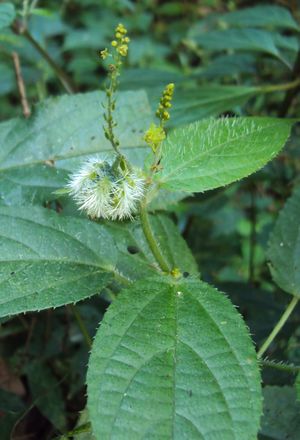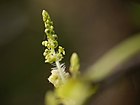Note: This is a project under development. The articles on this wiki are just being initiated and broadly incomplete. You can Help creating new pages.
Difference between revisions of "Tragia involucrata - Duhsparsha"
m (Prabhakar moved page Duhsparsha (Tragia involucrata) to Tragia involucrata - Duhsparsha) |
(→Identification) |
||
| (26 intermediate revisions by 2 users not shown) | |||
| Line 1: | Line 1: | ||
[[File:Tragia involucrata 06.JPG|thumb|right|''Duhsparsha'', ''Tragia involucrata'']] | [[File:Tragia involucrata 06.JPG|thumb|right|''Duhsparsha'', ''Tragia involucrata'']] | ||
| + | '''Tragia involucrata''' is a perennial twinning herb, covered with stinging hairs. Flowers are borne in racemes in leaf axils. Female flowers are few in lower part of inflorescence and male flowers are many in the upper part. Fruit is a 3-lobed capsule, containing 3 round smooth seeds. This herb is belongs to Euphorbeaceae family. | ||
| + | ==Uses== | ||
| + | {{Uses|Fever}}, {{Uses|Itching}}, {{Uses|Bronchits}}, {{Uses|Skin Diseases}}, {{Uses|Baldness}}. | ||
| − | + | ==Parts Used== | |
| + | {{Parts Used|Leaves}}, {{Parts Used|Roots}}. | ||
| − | + | ==Chemical Composition== | |
| − | + | Seeds yield a fixed oil containing about 62% linoleic acid and enzymes. They are also rich in proteins (Ghani, 2003).<ref name="chemical composition"/> | |
| − | + | ==Common names== | |
| − | + | {{Common names|kn=Turike Balli|ml=Kodithoova, Cherukodithuva|sa=Vrischikali|ta=Kanchori|te=Telukondicettu|hi=Barhanta|en=stinging nettle}}.<ref name="Common names"/> | |
| − | |||
| − | == | + | ==Properties== |
| + | Reference: Dravya - Substance, Rasa - Taste, Guna - Qualities, Veerya - Potency, Vipaka - Post-digesion effect, Karma - Pharmacological activity, Prabhava - Therepeutics. | ||
| + | ===Dravya=== | ||
| − | + | ===Rasa=== | |
| + | ===Guna=== | ||
| + | ===Veerya=== | ||
| + | ===Vipaka=== | ||
| + | |||
| + | ===Karma=== | ||
| + | |||
| + | ===Prabhava=== | ||
| + | |||
| + | ==Habit== | ||
| + | {{Habit|Annual herb}} | ||
| + | |||
| + | ==Identification== | ||
| + | ===Leaf=== | ||
| + | {{Leaf|Simple|Alternate|Leaves 6-10 x 3-5.5 cm, ovate or elliptic, base acute or rounded, margin serrate, apex acuminate, hispidulous on both sides}}<ref name="Leaf"/> | ||
| + | |||
| + | ===Flower=== | ||
| + | {{Flower|Unisexual|Axillary spikes|Greenish yellow|3|2 cm long; male flowers above, female flowers 1-2, at the base. Male flowers c. 1.5 mm across}} | ||
| + | |||
| + | ===Fruit=== | ||
| + | {{Fruit|Capsule|0.6 x 1cm||3-lobed, hispid|Seeds globose}} | ||
| + | |||
| + | ===Other features=== | ||
| + | |||
| + | ==List of Ayurvedic medicine in which the herb is used== | ||
| + | |||
| + | ==Where to get the saplings== | ||
| + | ==Mode of Propagation== | ||
| + | {{Propagation|Seeds}}. | ||
| + | |||
| + | ==How to plant/cultivate== | ||
| + | <ref name="How to plant/cultivate"/> | ||
| + | |||
| + | ==Commonly seen growing in areas== | ||
| + | {{Commonly seen|Tall grasslands}}, {{Commonly seen|Borders of forests and fields}}. | ||
| + | |||
| + | ==Photo Gallery== | ||
| + | <gallery class="left" caption="" widths="140px" heights="140px"> | ||
| + | Aagya (Marathi- आग्या) (3977248218).jpg | ||
| + | Barhanta (Hindi- बढन्त) (6225257497).jpg | ||
| + | Bichuti (Bengali- বিছুটি) (5089184494).jpg | ||
| + | Climbing Nettle (6225254731).jpg | ||
| + | Duhsparsha (Sanskrit- दुःस्पर्ष) (3977242156).jpg | ||
| + | Dumuni chorat (in Assamese) (5360458796).jpg | ||
| + | Kallaavi (Marathi- कळलावी) (6225771616).jpg | ||
| + | Kanchori (Tamil- காஞ்சொறி) (3977240600).jpg | ||
| + | </gallery> | ||
| + | |||
| + | ==References== | ||
| + | |||
| + | <references> | ||
| + | <ref name="chemical composition">[http://www.mpbd.info/plants/tragia-involucrata.php Chemical Constituents]</ref> | ||
| + | <ref name="Leaf">[https://indiabiodiversity.org/species/show/231373 Morphology]</ref> | ||
| + | <ref name="How to plant/cultivate">[Cultivation]</ref> | ||
| + | <ref name="Common names">Karnataka Aushadhiya Sasyagalu By Dr.Maagadi R Gurudeva, Page no:63</ref> | ||
| + | </references> | ||
| + | |||
| + | ==External Links== | ||
| + | * [https://www.ncbi.nlm.nih.gov/pmc/articles/PMC5412214/ Journal for African medicinal plants] | ||
| + | * [https://www.ncbi.nlm.nih.gov/pmc/articles/PMC3336427/ Some Pharmacognostical Characteristics of Tragia Involucrata Linn. Roots] | ||
| + | * [http://www.asia-medicinalplants.info/tragia-involucrata-l/ Tragia involucrata on asia-medicinalplants] | ||
| + | * [http://www.keralaayurvedics.com/herbs-plants/choriyanam-tragia-involucrata-ayurvedic-medicinal-herbs.html Tragia involucrata on keralaayurvedics] | ||
[[Category:Herbs]] | [[Category:Herbs]] | ||
| + | [[Category:Euphorbiaceae]] | ||
Latest revision as of 16:10, 25 August 2020
Tragia involucrata is a perennial twinning herb, covered with stinging hairs. Flowers are borne in racemes in leaf axils. Female flowers are few in lower part of inflorescence and male flowers are many in the upper part. Fruit is a 3-lobed capsule, containing 3 round smooth seeds. This herb is belongs to Euphorbeaceae family.
Contents
- 1 Uses
- 2 Parts Used
- 3 Chemical Composition
- 4 Common names
- 5 Properties
- 6 Habit
- 7 Identification
- 8 List of Ayurvedic medicine in which the herb is used
- 9 Where to get the saplings
- 10 Mode of Propagation
- 11 How to plant/cultivate
- 12 Commonly seen growing in areas
- 13 Photo Gallery
- 14 References
- 15 External Links
Uses
Fever, Itching, Bronchits, Skin Diseases, Baldness.
Parts Used
Chemical Composition
Seeds yield a fixed oil containing about 62% linoleic acid and enzymes. They are also rich in proteins (Ghani, 2003).[1]
Common names
| Language | Common name |
|---|---|
| Kannada | Turike Balli |
| Hindi | Barhanta |
| Malayalam | Kodithoova, Cherukodithuva |
| Tamil | Kanchori |
| Telugu | Telukondicettu |
| Marathi | NA |
| Gujarathi | NA |
| Punjabi | NA |
| Kashmiri | NA |
| Sanskrit | Vrischikali |
| English | stinging nettle |
.[2]
Properties
Reference: Dravya - Substance, Rasa - Taste, Guna - Qualities, Veerya - Potency, Vipaka - Post-digesion effect, Karma - Pharmacological activity, Prabhava - Therepeutics.
Dravya
Rasa
Guna
Veerya
Vipaka
Karma
Prabhava
Habit
Identification
Leaf
| Kind | Shape | Feature |
|---|---|---|
| Simple | Alternate | Leaves 6-10 x 3-5.5 cm, ovate or elliptic, base acute or rounded, margin serrate, apex acuminate, hispidulous on both sides |
Flower
| Type | Size | Color and composition | Stamen | More information |
|---|---|---|---|---|
| Unisexual | Axillary spikes | Greenish yellow | 3 | 2 cm long; male flowers above, female flowers 1-2, at the base. Male flowers c. 1.5 mm across |
Fruit
| Type | Size | Mass | Appearance | Seeds | More information |
|---|---|---|---|---|---|
| Capsule | 0.6 x 1cm | 3-lobed, hispid | Seeds globose | {{{6}}} |
Other features
List of Ayurvedic medicine in which the herb is used
Where to get the saplings
Mode of Propagation
How to plant/cultivate
Commonly seen growing in areas
Tall grasslands, Borders of forests and fields.
Photo Gallery
References
- ↑ Chemical Constituents
- ↑ Karnataka Aushadhiya Sasyagalu By Dr.Maagadi R Gurudeva, Page no:63
- ↑ Morphology
- ↑ [Cultivation]
External Links
- Ayurvedic Herbs known to be helpful to treat Fever
- Ayurvedic Herbs known to be helpful to treat Itching
- Ayurvedic Herbs known to be helpful to treat Bronchits
- Ayurvedic Herbs known to be helpful to treat Skin Diseases
- Ayurvedic Herbs known to be helpful to treat Baldness
- Herbs with Leaves used in medicine
- Herbs with Roots used in medicine
- Herbs with common name in Kannada
- Herbs with common name in Hindi
- Herbs with common name in Malayalam
- Herbs with common name in Tamil
- Herbs with common name in Telugu
- Herbs with common name in Sanskrit
- Herbs with common name in English
- Habit - Annual herb
- Index of Plants which can be propagated by Seeds
- Herbs that are commonly seen in the region of Tall grasslands
- Herbs that are commonly seen in the region of Borders of forests and fields
- Herbs
- Euphorbiaceae








